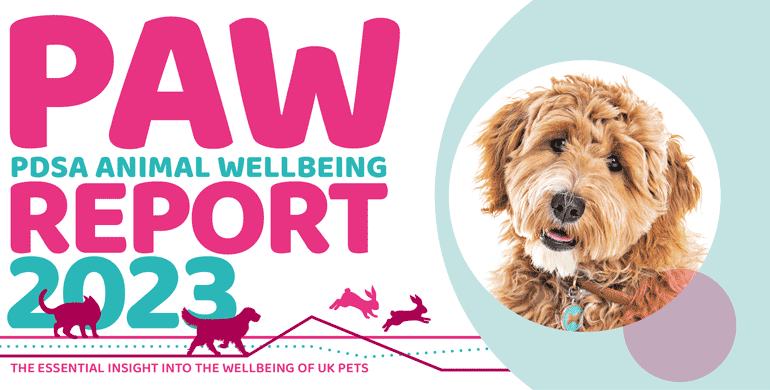Pet Acquisition
As might be expected from a nation of animal lovers, many people told us they chose to get a pet for an emotional connection and bond. The most common reason owners gave for deciding to get their pet was that they make them happy – 51% of dog, 45% of cat, and 35% of rabbit owners. 45% of dog, 36% of cat, and 30% of rabbit owners told us they got their pet for love and affection, and 37% of dog, 30% of cat, and 20% of rabbit owners got their pet for companionship.
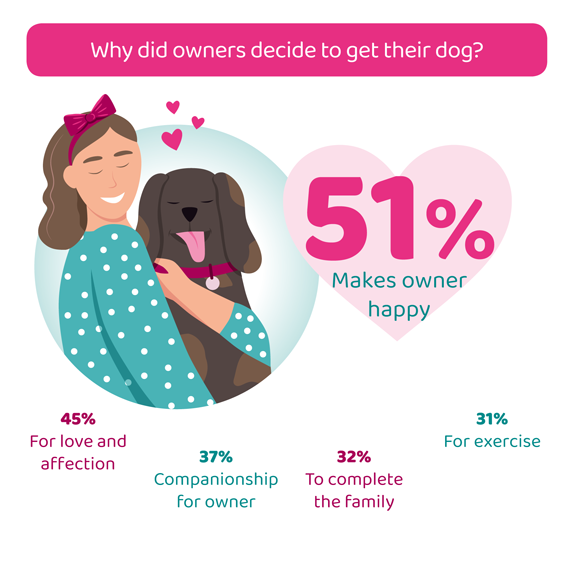
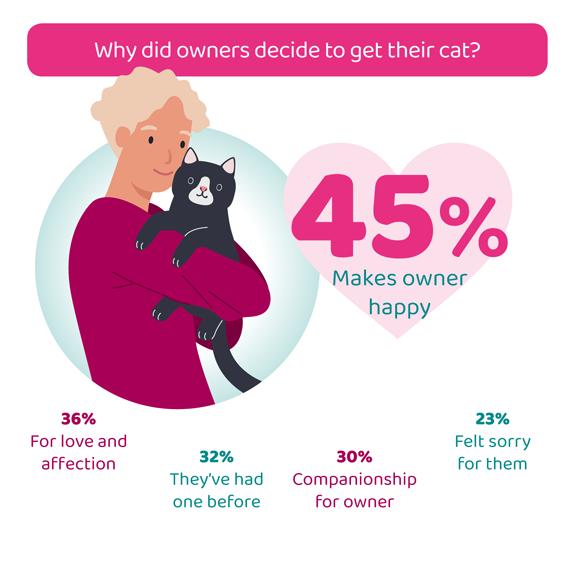
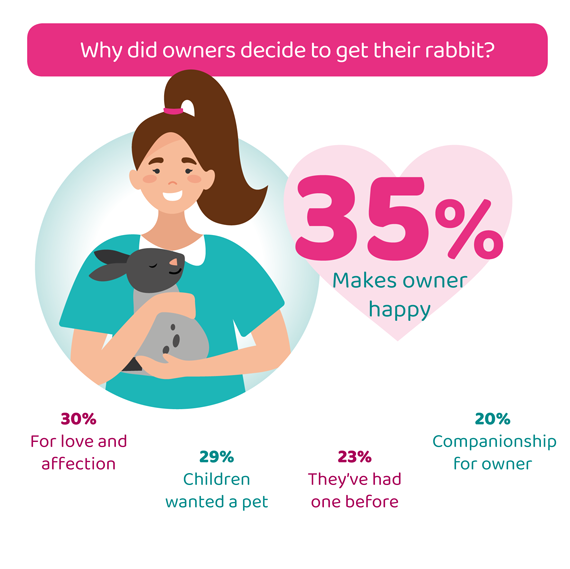
In 2023, rabbits continue to be a frequently chosen pet for children, despite their complex health and welfare needs, with 29% of owners telling us they got their rabbits because their children wanted a pet and 14% as companionship for their children. A much lower proportion of cat and dog owners gave these reasons – 12% of cat and 11% of dog owners got their pet because their children wanted them, and 7% of dog and 5% of cat owners got their pet as companionship for their children. A further 11% of rabbit owners told us they got their pet because they wanted their children to have more responsibility in life (a higher proportion than the 3% of cat and 3% of dog owners who said the same).
Pets can be a great way for children to learn empathy and responsibility2. However, the welfare of the pet must always be a priority when the decision is made to bring a pet into the family. Rabbits are a prey species and are likely to find noise and unpredictability of children stressful. In addition, children often wish to pick up and handle their pets, which many rabbits do not enjoy. Incorrect handling techniques can also leave rabbits at risk of severe injuries3.
Rabbits were also more likely to be an impulse buy for their owners, with 7% (equating to 72,000 rabbits) saying this is why they decided to get their pet, compared to 2% of dog owners (equating to 250,000 dogs) and 1% of cat owners (equating to 160,000 cats). Also, 7% of cat owners got their pet because they just turned up - this was a higher proportion than for dog (2%) and rabbit owners (3%). Both these findings could imply a lack of proper forethought and research by an owner before choosing their pet. It is essential that owners take the time to learn about the needs of their pet fully prior to obtaining them in order to understand whether they have the time, finances, and knowledge to adequately care for them. 33% of veterinary professionals chose 'lack of adequate pre-purchase education regarding suitable pet choice' as one of the top welfare issues they would choose to resolve tomorrow. Additionally, 24% chose 'lack of adequate pre-purchase education regarding suitable pet choice' as one of the top issues that would have the biggest health and welfare implication in ten years' time if not tackled.
Where did people get their pets from?
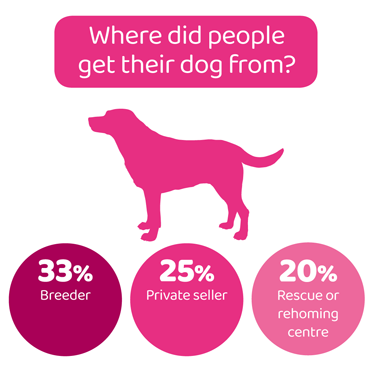
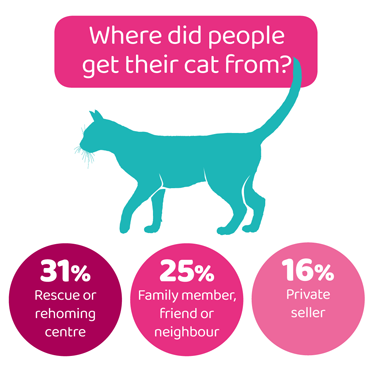
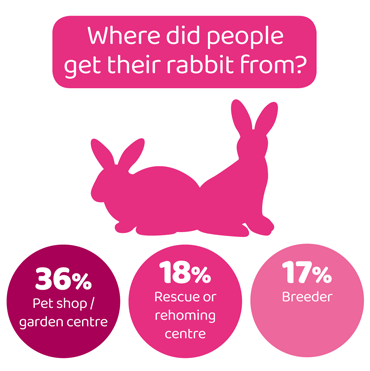
As we found in 2022, the most common places for people to get their dogs, cats and rabbits from have remained largely the same over the last 13 years. Dog owners were most likely to get their pets from a breeder (33%), cat owners from a rescue or rehoming centre (UK or abroad) (31%) and rabbit owners from a pet shop or garden centre (36%).
In 2022, we found that the number of cat and dog owners acquiring their pets from a UK rescue centre rehoming UK pets had fallen. This downward trend appears to have stabilised – the proportion of owners acquiring their pets from this source is unchanged in 2023 (13% of dogs and 29% of cats) compared to 2022 (14% of dogs and 27% of cats). In 2021, 17% of dog and 37% of cat owners told us they had acquired their pets from the same source.
Online pets
65% of owners told us they found their pet online, equating to 15 million pets, a significantly higher proportion than in 2022 when it was 53%. This proportion has increased for all species and is higher for dog owners (72%, 63% in 2022) than for cat (57%, 43% in 2022) and rabbit (55%, 45% in 2022) owners. The most common online sources for pets were dedicated websites, including online advertising sites (17% of all pet owners – 22% of dog, 13% of cat, and 14% of rabbit owners), rescue centres’ websites (16% of all pet owners, 14% of dog, 20% of cat, and 10% of rabbit owners) or individual breeders’ websites (10% of all pet owners – 14% of dog, 5% of cat and 7% of rabbit owners). This highlights the importance of the work that bodies like the Pet Advertising Advisory Group (PAAG) are doing to ensure that advertising of pets for sale online is done legally and ethically.
8% of pet owners told us that they had found their pet on social media – 8% of dog, 6% of cat and 12% of rabbit owners. This has increased for dog owners from 5% in 2022, despite rules prohibiting such activity being in place on many of these platforms. The lack of any formal regulation and oversight of these channels means that this is a concerning finding. It is important that owners continue to be supported to help them understand safe and ethical means of acquiring pets. 78% of veterinary professionals agree that there should be further improvements to the regulations for online sales of all pets.
Pets from abroad
Over the last few years, our findings have shown an increase in the proportion of pets coming from abroad. This increase seems to have slowed in 2023 when 6% of pets were acquired from abroad, which has not changed overall since 2022 – 3% from a UK based rescue centre for pets from abroad, 2% from a rescue or rehoming centre based abroad and <1% each from a breeder of one specific breed based outside of the UK or a breeder of multiple breeds based outside of the UK
However, the proportion of dogs acquired from abroad has increased to 8% of the total population, from 4% in August 2020, 6% in 2021 and 6% in 2022, equating to 900,000 dogs from abroad currently living in the UK. The proportion of cats acquired from abroad is lower in 2023 (3%) than in 2022 (5%) but still remains higher than in 2021 (1%) or 2020 (1%). 3% of rabbit owners told us they had acquired their pet from abroad (equating to 35,000 rabbits), no different from 2022 (3%) and 2020 (2%), although higher than 2021 (1%). 64% of veterinary professionals say they’ve seen an increase in pets imported from abroad in the last two years.
It is important for owners to know what country their pet has come from so they can be aware of any potential disease risk in the country of origin that could be different to the UK. In recent years, this has been a particular concern due to the introduction of exotic diseases in UK dogs. Out of the owners who acquired their dog from abroad*, 14% were not sure which country their dog had come from. 32% said their dog had come from Romania, with 7% from Spain, 6% from Cyprus and 6% from Ireland. Although brucellosis is endemic in several European countries, the rise in cases of brucellosis in UK dogs since 2020 has been partly attributed to the increased number of dogs entering the country from Romania4.
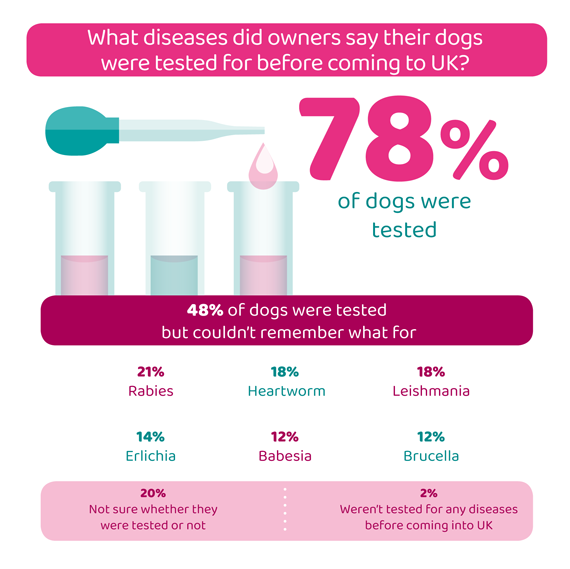
We asked owners of dogs from abroad if they knew what diseases, if any, their dog had been tested for before being imported. 78% of owners told us that their dog had been tested, which includes the 48% of all owners who didn’t know what diseases they had been tested for. 21% of owners told us that their dog had been tested for Rabies, 18% for Heartworm and 18% for Leishmania, but only 12% for Brucella. The first dog to human transmission of Brucella canis in the UK was reported in August 2022 and has led to calls for the mandatory testing of dogs for the infection prior to importation5.
61% of veterinary professionals told us they have seen an increase in exotic diseases in the last two years, including 30% who have seen an increase in leishmaniasis, 20% who have seen an increase in brucellosis, 17% who have seen an increase in heartworm and 13% who have seen an increase in ehrlichiosis.
As we had found in previous years, when we asked owners why they had chosen to obtain their pet from abroad, the most common reason was that they had no preference for where their pet came from, they just happened to come from abroad (37%). However, there was an increase in owners who told us they got their pet from abroad both because they were turned down by a UK rescue centre (18% in 2023, compared to 7% in 2022) and those who said they wanted to rescue from abroad (20% in 2023 compared to 8% in 2022), whereas those who said they got their pet from abroad because it was less expensive than buying from a UK seller has decreased (7% in 2023 compared to 12% in 2022).
3% of dog owners who got their pet from abroad told us they did so because they wanted a dog with cropped ears, meaning that in 2023 there are an estimated 29,000 dogs that have been imported because their owners wanted them to have a cosmetic mutilation surgery that is illegal in the UK. In addition, 2% of owners said they had chosen to import their pet because they wanted a dog with a docked tail (an estimated 22,000 dogs). 55% of veterinary professionals say in the last two years they’ve seen an increase in cropped ears.
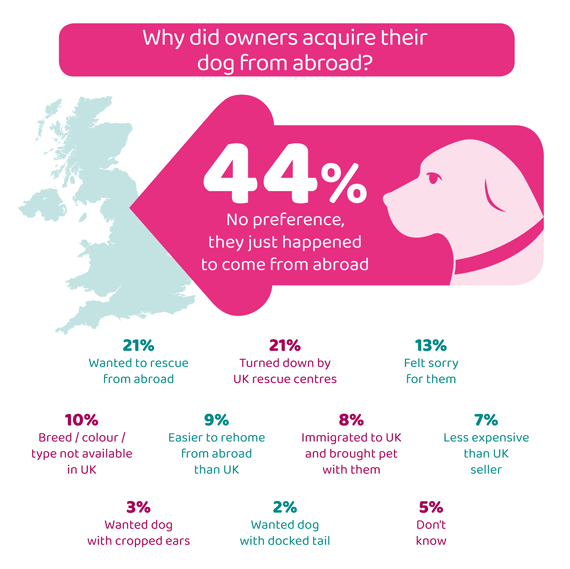
“With the PAW Report highlighting a growth in people buying their pet via online adverts and social media, it's more important than ever that buyers spend time asking the right questions to avoid untrustworthy sellers. It’s also imperative that prospective pet owners seriously consider whether a particular pet is a suitable choice for them.
The rising numbers of pets obtained from overseas poses disease risks for pets in the UK and, in some cases, to humans. Anyone looking to adopt from overseas should make sure that the animal has been appropriately tested for non-endemic diseases such as Brucella canis and Leishmania before importation. Additionally, prospective adopters must avoid importing dogs with mutilations such as cropped ears and docked tails."
Paula Boyden MRCVS, Veterinary Director at Dogs Trust and Chair of the Pet Advertising Advisory Group

Footnotes
*Excluding those owners who moved to the UK from abroad and brought their pet with them
2. Aral, N., Körükçü, Ö., & Kadan, G. (2022). Investigation of the Effect of Keeping Pets at Home and Playing Musical Instruments on the Empathetic Tendencies of Children. Theory and Practice in Child Development, 2(2), 58- 71
3. Buseth, M. E., & Saunders, R. (2014). Rabbit behaviour, health and care. CABI
4. Calls for vigilance following B canis cases in imported dogs - Veterinary Record - Wiley Online Library
5. Compassion v biosecurity: are dog rescues driving disease emergence? (wiley.com)

